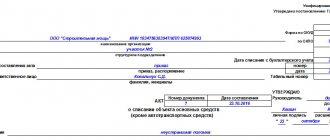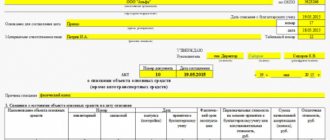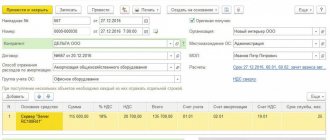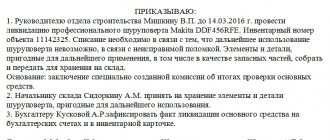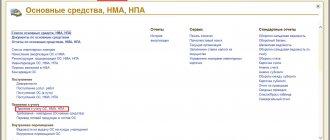Home / Bankruptcy / Bankruptcy of legal entities
Back
Published: 08/03/2019
Reading time: 5 min
0
274
In the event that an item of fixed assets is disposed of, or the owners realize that such an item is no longer capable of bringing economic benefits to the company or can no longer be used for production purposes, then it must be written off from accounting. Write-off is carried out through the process of liquidation of fixed assets.
- What is the liquidation of fixed assets and what are its goals?
- Progress of the procedure
- What documents are drawn up
- Rules for preparing the act
- Accounting entries
What is the liquidation of fixed assets and what are its goals?
The liquidation of fixed assets (fixed assets) means the process of writing them off from the balance sheet of an enterprise with the process of dismantling them due to physical or moral obsolescence.
Damage to a fixed asset (regardless of the possibility of its further use) entails mandatory inventory at the enterprise. This is indicated in paragraph 27 of the Regulations according to Order of the Ministry of Finance No. 34n of 1998.
The procedure for liquidating fixed assets from the balance sheet is prescribed in paragraphs. 94-97 Methodological guidelines for accounting, approved in Order of the Ministry of Finance of 1998 No. 33n. These standards today are advisory in nature for accountants and other responsible persons.
Liquidation of a fixed asset is necessary in the following cases:
- for its write-off in the event of an accident, natural disaster or other emergency and the impossibility of further use for its intended purpose or restoration;
- to write off an object due to its physical and moral wear and tear;
- in case of long-term non-use of the facility for the production of products , performance of work and provision of services or for management purposes;
- in other cases established by law.
Liquidation of a fixed asset can be complete or partial. In the latter case, we are talking about this type of write-off when a certain part of the object can be used in the future (for example, as raw materials in production or for the repair of fixed assets).
Related documents
- Certificate of acceptance and transfer of fixed assets. Form No. os-1
- Cash audit report (instruction of the Central Bank of the Russian Federation dated 10/04/93 No. 18 (as amended on 02/26/96)
- Act of markdown of goods
- Act-receipt for the performance of warranty and paid work on the repair of telephone sets. Form No. tf-2-22 (letter of the Ministry of Finance of the Russian Federation dated February 22, 1994 No. 16-36)
- Act-request for replacement (additional supply) of materials. Form No. m-10
- Analytical data on accounting for the costs of procuring and purchasing materials for journal order No. 6
- Analytical data on accounting for deviations in the cost of materials for journal order No. 6
- Certificate of assessment of the value of buildings and structures approved. Ministry of Agriculture of the Russian Federation on January 22, 1992 (appendix to the regulations on the commission for the privatization of land and reorganization of the collective farm (state farm)
- Certificate of assessment of the cost of machinery, equipment and transport (appendix to the regulations on the commission for the privatization of land and reorganization of the collective farm (state farm), approved by the Ministry of Agriculture of the Russian Federation on January 22, 1992)
- Certificate of assessment of the cost of unfinished capital construction (appendix to the regulations on the commission for the privatization of land and reorganization of the collective farm (state farm), approved by the Ministry of Agriculture of the Russian Federation on January 22, 1992)
- Act on the assessment of the value of working capital (appendix to the regulations on the commission for the privatization of land and reorganization of a collective farm (state farm), approved by the Ministry of Agriculture of the Russian Federation on January 22, 1992)
- Act of transfer (sale) of collective farm (state farm) property to the rural (settlement) council of people's deputies (appendix to the regulations on the commission for land privatization and reorganization of the collective farm (state farm), approved by the Ministry of Agriculture of the Russian Federation on January 22, 1992)
- An acceptance certificate
- Balance sheet of an insurance organization (quarterly). Form No. 1-insurer (Order of Rosstrakhnadzor dated April 16, 1996 No. 02-02/12)
- Balance sheet of the enterprise (Form No. 1 for capital) (approved by Letter of the Ministry of Finance of the Russian Federation dated October 13, 1993 No. 114 for annual reporting for 1993)
- Balance sheet of an insurance organization - form No. 1 - insurer. (approved by the Russian Federal Service for Supervision of Insurance Activities in agreement with the Ministry of Finance of the Russian Federation for quarterly reporting in 1993)
- Balance sheet of economic and financial activities of the enterprise
- Balance sheet of economic and financial activities of the enterprise form 1.
- Statement of uncollected overdue receivables and violations of settlement discipline on synthetic accounts
- Statement of receipt of funds to the account of a branch of a foreign legal entity. Form No. 1-vpp (instruction of the State Tax Service of the Russian Federation dated June 16, 1995 No. 34 (as amended on December 29, 1995 No. vz-6-06-672))
Progress of the procedure
Previously, the process of writing off fixed assets was strictly regulated. During this procedure, a special commission was necessarily created, which was supposed to make the final decision on liquidation. Now this norm is not mandatory and write-off of fixed assets is carried out according to the rules established by local documents.
The requirements of Federal Law No. 402 “On Accounting” on the procedure for liquidation are advisory in nature, but are often practiced today.
The liquidation procedure for fixed assets involves the following stages:
- At the preparatory stage, the feasibility of further use of fixed assets, the effectiveness or ineffectiveness of restoration is determined . For this purpose, by order of management, a special commission of competent employees may be appointed. It usually includes accountants and persons responsible for the safety of fixed assets. Outside experts and inspectors may be invited to participate in the work of the commission. Based on the results of the commission's registration, an order is usually issued.
- Next comes the stage of the commission's work . The competence of the commission includes: inspection of the facility using certain technical documentation; establishing the impossibility of its use; assessment of the reasons for writing off an object; assessment of the possibility of using individual components and assemblies of the object and its assessment; control over the withdrawal of precious metals and non-ferrous metals from fixed assets; determining the weight of the object and transferring it to the warehouse, etc.
- The results of the commission's work and the decisions it makes are documented . Based on the results of the commission’s work, a decision may be made to write off a fixed asset or to repair it or disassemble it into spare parts. The decision made must be justified: members of the commission should indicate the reasons that prompted them to liquidate fixed assets.
- Parts, assemblies and assemblies (for example, suitable for repairing other operating systems) are received as scrap or waste , and unusable ones are received as recyclable materials.
- A note about disposal of fixed assets is made in the inventory card or book.
- An order to liquidate a fixed asset is created.
What documents are drawn up
In the process of liquidating fixed assets, you need to prepare some mandatory documents:
- Certificate of liquidation of fixed assets.
- Inventory accounting card, form No. OS-6 (or other document accepted by the company for accounting of fixed assets). Filling out this card completes the process of liquidation of a fixed asset.
- Act on an accident or accident that led to the impossibility of further use of fixed assets.
- A document confirming the removal of the vehicle by the traffic police (if the car is written off).
- Order to liquidate a fixed asset.
Rules for preparing the act
In the process of liquidation of fixed assets, it is imperative to document this process and draw up an act on the liquidation of fixed assets. The act of liquidation of fixed assets is prepared based on the results of the inventory.
Currently, unified accounting forms are no longer mandatory for use. Therefore, when preparing an act, accountants can develop the form of the act independently. Information from the Ministry of Finance No. PZ-10/2012 also indicates this. If the company develops the form independently, then it must be fixed in the accounting policy for accounting.
But quite often accountants use the unified form of the act on write-off of fixed assets No. OS-4. It was approved by the State Statistics Committee in Resolution No. 7 of 2003. A unified form allows you to avoid mistakes and take into account all the mandatory information that must be contained in this document.
In the column “Original cost as of the date of acceptance for accounting or replacement cost” for fixed assets that have undergone revaluation, the replacement value at the last revaluation is indicated. If the objects have not been revalued, then the initial valuation is recorded at the time the asset was accepted for accounting.
The column with the amount of depreciation indicates the amount of depreciation since the initial operation.
The costs of writing off fixed assets and the cost of material assets that were received as a result of disassembly are indicated in section 3 “Information on the costs associated with writing off fixed assets from accounting and on the receipt of material assets from their write-off.” This section indicates the cost of spare parts and materials that remain after disassembly and can be useful in production.
The act in form No. OS-4 is prepared in 2 copies. It must be signed by the commission members and the head of the organization. The first copy of the act is subject to transfer to the accounting department and will serve as the documentary basis for writing off the object from the register, and the second copy remains with the responsible person. Such a person, who is responsible for ensuring the safety of fixed assets, is appointed by order of the head of the enterprise.
A second copy may also be needed in case materials remaining from liquidation are transferred to the warehouse. Information about the costs incurred for liquidation and the cost of materials is written down in section 3 of the act in form No. OS-4.
It is worth considering that the form of the act used may vary depending on the type of fixed asset or the specifics of the situation:
- To write off vehicles, you can use the act of writing off vehicles in form No. OS-4a.
- When writing off a group of fixed assets - an act in form No. OS-4b “Act on writing off groups of fixed assets”.
A sample act of liquidation of fixed assets can be downloaded here.
“1C: Public Institution Accounting 8”: partial liquidation of a fixed asset
In the Instructions for the application of the Chart of Accounts for budgetary accounting (Order of the Ministry of Finance of Russia dated December 6, 2010 No. 162n), Instructions for the application of the Chart of Accounts for accounting of budgetary institutions (approved by Order of the Ministry of Finance of the Russian Federation dated December 16, 2010 No. 174n), hereinafter referred to as Instruction No. 174n, Instructions on the application of the Chart of Accounts for accounting of autonomous institutions (approved by Order of the Ministry of Finance of the Russian Federation dated December 23, 2010 No. 183n) there are no accounting entries that reflect the partial liquidation of a fixed asset. From the article you will learn how to correctly reflect the partial liquidation of a fixed asset - so that all changes are reflected in the Inventory card of the object.
Changes in the initial (book) value of non-financial asset objects occur in cases of completion, additional equipment, reconstruction, modernization, partial liquidation (dismantling), as well as revaluation of non-financial asset objects. This follows from the provisions of paragraph 27 of the Instructions for the application of the Unified Chart of Accounts for public authorities (state bodies), local governments, management bodies of state extra-budgetary funds, state academies of sciences, state (municipal) institutions (approved by Order of the Ministry of Finance of Russia dated 01.12 .2010 No. 157n), hereinafter referred to as Instruction No. 157n.
According to paragraph 12 of Instruction No. 174n, the disposal of fixed assets can be recorded in various accounting entries. It depends on the reason for writing off the fixed asset:
- upon disposal of a fixed asset against the will of a budgetary institution (in case of identified shortages, thefts, facts of destruction of fixed assets during terrorist attacks) - by debiting the corresponding analytical accounts of account 010400000 “Depreciation” (010411410-010413410, 010415410, 010418410, 010421410-010 428410, 010431410 -010438410, 010441410-010448410), account 040110172 “Income from transactions with assets” and the credit of the corresponding analytical accounting accounts, account 010100000 “Fixed assets” (010111410-010113410, 010115410, 010118410, 0 10121410-010128410, 010131410-010138410, 010141410-010148410) ;
- in case of destruction, destruction, rendering unusable due to natural disasters (other disasters, natural phenomena, catastrophes) - by debiting the corresponding analytical accounts of account 010400000 “Depreciation” (010411410-010413410, 010415410, 010421410-010428410, 010431410-0104 38410, 010441410-010448410 ), account 040120273 “Extraordinary expenses for transactions with assets” and the credit of the corresponding analytical accounts, account 010100000 “Fixed assets” (010111410-010113410, 010115410, 010121410-010128410, 010131410-01013841 0, 010141410-010148410);
- when making a decision to write off for other reasons, including due to physical or moral wear and tear of an accounting object - by debiting the corresponding analytical accounting accounts, account 010400000 “Depreciation” (010411410-010413410, 010415410, 010421410-010428410, 010431410-010438 410), accounts 040110172 “Income from operations with assets” and the credit of the corresponding analytical accounts of account 010100000 “Fixed assets” (010111410-010113410, 010115410, 010121410-010128410, 010131410-010138410).
In our opinion, partial liquidation of OS is formalized in a similar way.
Let's look at how to formalize the partial liquidation of a fixed asset in the 1C: Public Institution Accounting 8 program using the example of a set of furniture damaged during a fire.
Example
| During the fire, individual pieces of a set of furniture, counted as one inventory item, burned down. The partial liquidation of an asset is reflected in the following accounting entries: Debit 104.xx.410 Credit 101.xx.410 - for the amount of write-off of depreciation on the burnt part of the asset. Debit 401.20.273 Credit 101.xx.410 - for the amount of write-off of the residual value of the burnt part of the fixed asset. |
In the 1C: Public Institution Accounting 8 program there is no special document to reflect the partial liquidation of a fixed asset, therefore these transactions should be entered using the Transaction (accounting) document. An example of such an operation is shown in Figure 1.
Rice. 1. Entering transactions using the document “Operation (accounting)”
If a straight-line depreciation method was used for an asset that was partially liquidated, and the remaining useful life needs to be changed for further depreciation calculation, then you should enter the Depreciation Adjustment document, changing the useful life. The remaining useful life will be recalculated automatically in the document.
The date of the Depreciation Adjustment document must be identical to the date of the Transaction (accounting) document, which reflects the decrease in the value of fixed assets, and the time of the Depreciation Adjustment document must be later, at least by a few seconds, so that the change in the residual value of fixed assets is taken into account (see Fig. 2 ).
Rice. 2. Entering the document “Adjustment of depreciation”
Thereafter, the monthly depreciation amount will be calculated based on the new residual value and the new remaining useful life.
If the book value of an asset due to partial liquidation has become less than 40,000 rubles, then you should not add additional depreciation to 100% of the book value. There is no reason for this, since according to paragraph 92 of Instruction No. 157n, depreciation in the amount of 100% is calculated in the following order:
- for a real estate object worth up to 40,000 rubles inclusive, depreciation is charged in the amount of 100% of the book value of the object upon acceptance for accounting;
- for objects of the library collection worth up to 40,000 rubles inclusive, depreciation is accrued in the amount of 100% of the book value when the object is put into operation;
- for other fixed assets worth from 3,000 to 40,000 rubles inclusive, depreciation is accrued in the amount of 100% of the book value when the object is put into operation.
While a partially liquidated fixed asset item had already been previously accepted for accounting and put into operation.
It should be noted that information about changes in the book value of an asset should also be reflected in the section “Reconstruction, modernization, completion, additional equipment, partial liquidation” of the inventory card (f. 0504031).
But this section of the inventory card does not take into account transactions on accounting accounts reflected in the Operation (accounting) document, but only displays the movements generated in the program by the document Overhaul, modernization, which is intended for issuing an acceptance certificate for repaired, reconstructed and modernized objects, and also for changing the initial cost of fixed assets in connection with the completion, retrofitting, reconstruction or modernization of relevant facilities, and is not suitable for reflecting the partial liquidation of fixed assets.
Information about the partial liquidation of an asset for output in the section Reconstruction, modernization, completion, additional equipment, partial liquidation of the asset inventory card should be entered using the document Entering the history of overhaul and modernization on the Modernization tab.
In the Amount of modernization column of the tabular part of the document, you should enter the amount of partial liquidation of the fixed asset in the amount of the reduction in the book value with a minus sign.
The date of the document Entering the history of overhaul and modernization and the Date of modernization are indicated the same as the date of the document Operation (accounting), which reflected the accounting records of the partial liquidation of the operating system (see Fig. 3).
Rice. 3. Entering the history of major repairs and modernization
In the inventory card for accounting for fixed assets (f. 0504031), after reflecting the partial liquidation of the fixed asset, the following are changed downwards along the line displayed on the date of formation of the inventory card (see Fig. 4):
- book value of the object in column 6 Initial (replacement), cadastral value, rub.,
- the amount of accrued depreciation in column 11 Accrued from the beginning of operation, rub.
Rice. 4. Decrease in book value in the Fixed Asset Inventory Card
It should be noted that in the directory Fixed Assets, Intangible Assets, Legal Entities, in the Initial Cost attribute, the amount of the initial cost of the fixed assets object is stored, which is displayed in the inventory card for recording fixed assets in column 6 Initial (replacement), cadastral value, rub. on the date when the program reflected the first entry for this fixed asset item.
After partial liquidation of an asset, you should not change the value of the initial value, since the change in the book value of the asset occurred later, and the new book value will be displayed in the inventory card according to accounting data on a different, later date - on the date of formation of the inventory card (see .Figure 4).
Information about the partial liquidation of a fixed asset, reflected in the document Entering the history of major repairs and modernization, is displayed in the inventory card for recording fixed assets (form 0504031) in the section Reconstruction, modernization, completion, additional equipment, partial liquidation (see Fig. 4).
Thus, accounting for the partial liquidation of a fixed asset consists of the following steps:
1. Decrease in book value and accrued depreciation using the Transaction (accounting) document.
2. Adjustment of the residual value of a fixed asset and its remaining useful life for calculating depreciation using the Depreciation Adjustment document.
3. Reflection of information about the partial liquidation of the OS for output in the inventory card using the document Entering the history of overhaul and modernization.
From the editor. Read detailed recommendations on accounting for fixed assets in 1C: Public Institution Accounting on the IS 1C:ITS website https://its.1c.ru/db/metbud81#browse:13:-1:1977:1978:2020:2031: 2032:2034. On how to change the useful life of a fixed asset - https://its.1c.ru/db/metbud81#content:5465:1, how to put into operation a part of a fixed asset from a group - https://its.1c. ru/db/metbud81#content:4492:1.




